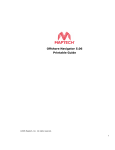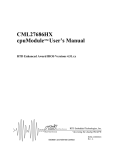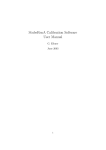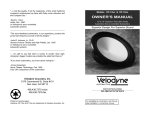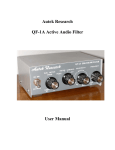Download ATI Technologies M100 Specifications
Transcript
M100 MICROPHONE AMPLIFIER OPERATING AND MAINTENANCE MANUAL © Copyright 1997-2005, Audio Technologies Incorporated - Printed in USA Audio Technologies Inc. | 154 Cooper Road #902 | West Berlin, NJ 08091 | Voice 856-719-9900 | Fax 856-719-9903 | www. audio.com GENERAL The ULTIMIKE M100 Microphone Amplifier is designed specifically to provide the ultimate in no-compromise audio performance. A rugged, small AC line powered amplifier, it may be placed close to the mike on the stage, in the pulpit or in the overhead lighting structures to shorten sensitive low-level mike lines. Replacing your long runs of low-level mike cable with high level feeds will greatly reduce your susceptibility to RF, hash and hum pickup. In addition, the M100 is itself very well protected from both radiated and conducted interference and has unmatched broadband common made rejection to cancel microphone hum and RF pickup. A unique distortion-free transformer coupled output provides total isolation of ground loops and ground voltage differentials while simultaneously providing a low driving impedance to minimize high frequency rolloffs die to excess cable capacity. To allow you to install the M100 close to the mike when necessary in what may be a remote or poorly accessible location, we have designed the preamp to accept a very wide range of input levels (up to 0 dBu) without input overload and we have incorporated a switchable slow acting (but very low distortion) 24 dB limiter to turn down the output level pot when you can’t reach it. In Addition to all these modern conveniences, the ULTIMIKE is a superb performer with ruler flat response, no ringing, excellent CMR, exceptionally low input noise, and trivial distortion. The ULTIMIKE amplifier is packed in a rugged, compact steel enclosure. All controls and connecters are recessed for protected reverse side of a identification markings are printed on the protected reverse side of a heavy duty polycarbonate overlay. All power supply components are well shielded by the steel wrap-around. Input mike level audio to the ULTIMIKE must run a gauntlet of ferrite suppressors, bypass capacitors, DC blocking capacitors, and protection diodes designed to block the trash and transistors (Q1 and Q2) in an instrumentation amplifier configuration provide a very low noise input gain stage. The balanced feedback network R12, R13, R20, and R 21 is driven from the outputs of A1A and A2A to eliminate any input loading that might degrade common mode hum rejection and to allow use of low valued feedback resistors for minim noise Generation. Dual constant current stages (Q3 and Q4) sink DC emitter current from Q1 and Q2 and allow complete servo cancellation of input offsets via integrator A3A to maximize input stage headroom at A2B. A different amplifier and limiter are formed by A1BA2B. Common mode input signals are nulled out by R27 and a LDR (light dependant resistor) in A2Bs feedback loop reduces the input stage gain in response to limiter levels. Even without limiting the input stage will handle input levels up to 0 dBm (gain – HI switch) or +20 dBm (gain –20 dB). A3B forms a variable gain stage with a smooth logarithmic adjustment range of +37 to – 19 dB. R30, the level potentiometer is screwdriver adjustable through the front of the Audio Technologies Inc. | 154 Cooper Road #902 | West Berlin, NJ 08091 | Voice 856-719-9900 | Fax 856-719-9903 | www. audio.com amplifier. When rack mounted, the level adjustment is accessible through the panel. A4A makes a switchable, unity gain high pass filter with two-pole response starting down (-3 db) at 150 Hz and rolling off 400 dB at 15 Hz. The filter is switched in or out of the circuit with S4. The output line driver A4B and output transformer T2 provide 16 dB of gain and the total isolation, faraday shielding, RF immunity and ease of use a true transformer coupled balanced output. A unique feedback technique totally avoids the transformers characteristic limitations of high distortion, poor response and hum pickup. Typical output distortion measurements made at both peak (+22 dBm) and nominal (+4 dBm) levels barely exceed generator residuals from 20 to 20,000 Hz. Hum pickup from the power supply is well below the noise level and low frequency response is greatly extended. The output is protected from shorts but will drive over half mile of shielded cable with less that 1 dB of signal rolloff at 20,000 Hz. We deliberately omit the output connector pin 1 ground lift jumper (W4). If you insist on setting up loops by grounding your cable shields at both ends you van connect the shield to the output connector plug shell. A5A and A5B make an active full wave rectifier and filter to drive the limiter. R5 sets a limiting threshold corresponding to an output level of +14 dBm. The limiter has a soft knee and a gentle slope of about 4:1 so that continued peaks greater that 10 dB above the nominal output will cause a slow reduction in gain. If the limiter switch is off, the front yellow LED will light on sustained peaks to tell you to use the limiter or to reduce the gain. With the limiter on, an occasional flash will indicate normal operation but sustained illumination is an indication that you are reaching the end of the gain reduction range. Q5 is a constant current driver for the limiter LDR, which can be controlled by am external 10 Kohm potentiometer plugged into the phono jack type connector. The remote gain control has an adjustment range of 0 to –15 dB and does not interact with the limiter expect that both share the 24 dB total gain reduction range of the LDR. The remote gain control is DC operated and can operate a considerable distance from the M100 without pickup. A5C and A5D form a 40 kHz DC-to-DC converter to efficiently generate the +48 VDC microphone phantom power. Your M100 operates from a internal, double filtered bipolar 16 VDC supply, which uses a couple of unique regulated devices called zener diodes. In contrast to fancy three terminal regulators, these devices will live through power line trash and transients and simultaneously protect your valuable circuitry. The supple is designed for minimum susceptibility to power line conducted RF and hash with bypassed ferrite beads, RC primary side bypasses and a mu-metal shielded, non-concentric wound, semi-toroidal power transformer. A large board mounted 1/2A AC line fuse protects your M100 but Audio Technologies Inc. | 154 Cooper Road #902 | West Berlin, NJ 08091 | Voice 856-719-9900 | Fax 856-719-9903 | www. audio.com can make taking off the cover with the AC line still connected into a very exciting adventure. Different types of attachment plugs or line cords may be required for connection to alternate supply voltage. INSTALLATION MOUNTING The M100 can mount to any flat surface with the included angle brackets, which should be mounted to opposite small faces if the M100 by the cover screws. The M100 can be rack mounted either singly or in pairs in only1 ¾” using accessory Front Panel Kit, P/N20273-501. GROUNDING The M100 includes an output transformer, beaded, bypassed and clipped input network, a triple protected AC input, and a double ground plane PC boarded and a will shielded magnetic enclosure. However, in a difficult broadcast application, RF levels may require a better ground path for the RF bypass networks than can be provided by the third wire AC ground and a separate studio inductance ground bus tied to the chassis may be necessary low inductance studio ground bus tied to the chassis may be necessary. The power line ground could cause a loop with a separate studio ground. If you are sure your studio ground will provide adequate protection to your personnel in case pf an accidental AC short to the chassis, a 3 to 2 adapter can be used to isolate the power line ground. We strongly recommend that the adapter be removed and the power line ground be reconnected prior to any service work requiring removal of the studio ground from the chassis. INOUT AND OUTPUT CABLES The female XLR type input connector is wired conventionally with pin 2 HI and pin 1 and the connector housing grounded. +48 VDC Phantom power is applied to both pins 2 and 3 with reference to ground on pin 1. The male XLR type output cable connector is wired with pin 2 HI, pin 3 LO and pin 1 floating. The connector housing is grounded to the chassis. Pin 1os a left ungrounded to prevent large loop currents from circulating through the cable shield if inadvertently grounded at both ends. The shield should be grounded at the receiving end of the signal. If absolutely necessary to ground pin 1, grounded lift jumper W4 can be inserted into the circuit board. Audio Technologies Inc. | 154 Cooper Road #902 | West Berlin, NJ 08091 | Voice 856-719-9900 | Fax 856-719-9903 | www. audio.com NOTE Output transformers blocking RF and interrupting ground loops MUST be properly loaded in order to provide flat response and minimum overshoot. Always be sure that the output sees a 600 ohm load across pins 2 and 3. An occasional double load (300 ohms) is better than no load. REMOTE GAIN TRIM CONTROL A 10 Kohm linear potentiometer can be connected across a single conductor shielded cable with a standard RCA type phono plug at the M100 end. Connect the arm and one end of the pot together and to the shield, connect the other end of the pot to the center conductor. Decreasing resistance will cause decreasing gain to a limit of approximately 15 dB change. If you use a pot of lower value than 10 K, you will be unable to achieve full gain at maximum resistance. The maximum length you can run the remote gain control cable is somewhere between three feet and mile. MAINTENANCE There is no routine maintenance required by your ULTIMIKE amplifier. If you have a problem while using the M100, eliminate by substituting the microphone, cables, connectors, load, and AC power and switch positions as possible causes before attacking the M100. DISASSEMBLY 1. 2. 3. 4. Remove AC power. Remove nine Philips head screws. Pull off switch protector bracket. Unlock both XLR connector PC board mounted center inserts from their cover mounted outer shells using an .090 wide screwdriver placed into an access hole located above the three terminals in each insert. Give each 1/8 turn CCW to unlock; slot is horizontal when locked. DO NOT FORCE. 5. With your thumbs on the connector inserts and your fingertips on the sides of the cover, gently slide the cover forward until the connector shells clear the inserts. Lift the cover clear and pull the line cord grommet clear of the cover. 6. Reassembly is the reverse of the above. Don’t forget the grommet. ADJUSTMENTS Avoid the temptation to diddle the internal trimpots R27 and R40 just to see what affects they cause. Both are sharp null type settings, which are greatly degraded by even slight misadjustment. Replacement of any semiconductor in the unit should not require pot Audio Technologies Inc. | 154 Cooper Road #902 | West Berlin, NJ 08091 | Voice 856-719-9900 | Fax 856-719-9903 | www. audio.com readjustment. Audio Technologies Inc. | 154 Cooper Road #902 | West Berlin, NJ 08091 | Voice 856-719-9900 | Fax 856-719-9903 | www. audio.com COMMON MODE REJECTION Replacement of R6, R7, R8, R9, R62, C11, or C12 will require readjustment of R27 to maintain maximum common mode rejection (CMR). To set R27 apply 10 Vrms at 60 Hz between ground pin 1, pin 2, and pin 3 (tied together) of XLR input J1. Measure output (at J2 pins 2 to 3) and adjust R27 for null. A 90 dB CMR is attainable but may be difficult to measure without a turned voltmeter. DISTORTION Replacement of R36, R37 R38, R39, and R40 or output transformer T2 will require readjustment of R40. Apply sufficient 20 Hz signal to the input with the gain switch at – 20 dB and the gain control set to 12 o‘clock to drive the loaded output to +20 dBm. Measure Total Harmonic Distortion (THD) at the output and adjust R40 for the best null. If you cannot detect a good null your audio generator may well have more internal distortion at 20 Hz than even the untrimmed contribution of the M100, which is typically less than .25%. When properly set, using superior test equipment such as Amber or Audio Precision distortion measurements should be limited only by residual white to levels of .03% across the audible band. GENERAL Power supply voltages are + and – 16 VDC nominal. IC output DC voltages under no signal, shorted input conditions should read 0 VDC at A1 and A2, pins 1 and 7, A3-7, A4-1 and 7 and A5, pin 1 and 6. A3 pin 1 should read within the range of + to –10 VDC and a 28 Vp-p square wave should be visible with an oscilloscope at A5, pins 8 and 14. Deviations of more than .1 VDC from the 0 VDC nominal is an indication of IC or circuit problems. Ten years from now replacing all aluminum electrolytic capacities. Keep 250 Watt soldering guns out of the M100. MODIFICATIONS 230 VAC OPERATION The M100 is wired for 115 VAC, 50/60 Hz operations unless otherwise requested at the time of ordering. It can be modified for 230 VAC use by removing W1 and W3 and inserting a jumper wire in W2. Audio Technologies Inc. | 154 Cooper Road #902 | West Berlin, NJ 08091 | Voice 856-719-9900 | Fax 856-719-9903 | www. audio.com TECHNICAL SPECIFICATIONS GAIN 54 dB nominal, adjustable 0 to 74 dB. NOMINAL POWER -50 dBm / 150 ohms available input power +4 dBm / 600 ohms output. PEAK LEVELS -32 dBu in, +22 dBm out. MAXIMUM INPUT 0 dBu- HI gain switch, +20 dBu- LO gain switch NOISE OUTPUT -70 dBm, 20 to 20,000 Hz measurement bandwidth HUM OUTPUT -80 dBm, 60, 120, and 80 Hz. DYNAMIC RANGE 92 dB, peak output to noise. HARMONIC DISTORTION 20 to 20,000 Hz .10% THD maximum at peak level. .03% THD maximum at nominal level. INTERMOD DISTORION .005% maximum SMPTE 7K / 60 Hz 4:1. FREQUENCY REPONSE 20 to 20,000 Hz +0, -.25 dB. -3 dB at 1 Hz and 65 kHz. HIGH PASS FILTER -3 dB at 150 Hz nominal, -40 dB at 15 Hz. INPUT HUM REJECTION 90 dB minimum adjustment. INPUT IMPEDANCE 40 kohms, balanced. OUPUT IMPEDANCE Transformer balanced, 40 ohms source impedance, 600 ohms +/- 10% load impedance OUTPUT RISE TIME 6 uSec symmetric rise and fall times, typical. OUTPUT OVERSHOOT 5% maximum. PHASE SHIFT 30 degrees maximum input to output, 20 to 20,000 Hz. CMR, internal Audio Technologies Inc. | 154 Cooper Road #902 | West Berlin, NJ 08091 | Voice 856-719-9900 | Fax 856-719-9903 | www. audio.com COMPRESSOR THRESHOLD +14 dBm out +/- 1 dB. COMPRESSOR SLOPE 4 : 1 maximum. COMPRESSOR TIMING 100 mSec attack and recovery. COMPRESSOR RANGE 20 dB gain reduction minimum REMOTE GAIN TRIMMER 10 kohm linear external pot, user supplied DC control, 0 to –15 dB range. PHANTOM POWER +48 VDC at 4 ma. through paralleled 6.8 Kohms resistors. AC POWER 115 – 230 VAC +/- 10%, 47 to 63 Hz, 4 VA. DIMENSIONS 1.5” H by 8.5” W by 5.5” D(9.75” W with mtg brackets); 3lbs. Net, 5lbs. Shipping weight. ENCLOSURE Plated steel wraparound with reverse printed graphics overlay and rugged switch protector. MOUNTING Keyhole slot #8 screws on 9 1/8” centers accessory rack mount. CONNECTORS Mike input, XLR type, three terminal female line output, XLR type, three terminal male. Remote Gain Trimmer, RCA type Phone Jack. Audio Technologies Inc. | 154 Cooper Road #902 | West Berlin, NJ 08091 | Voice 856-719-9900 | Fax 856-719-9903 | www. audio.com









